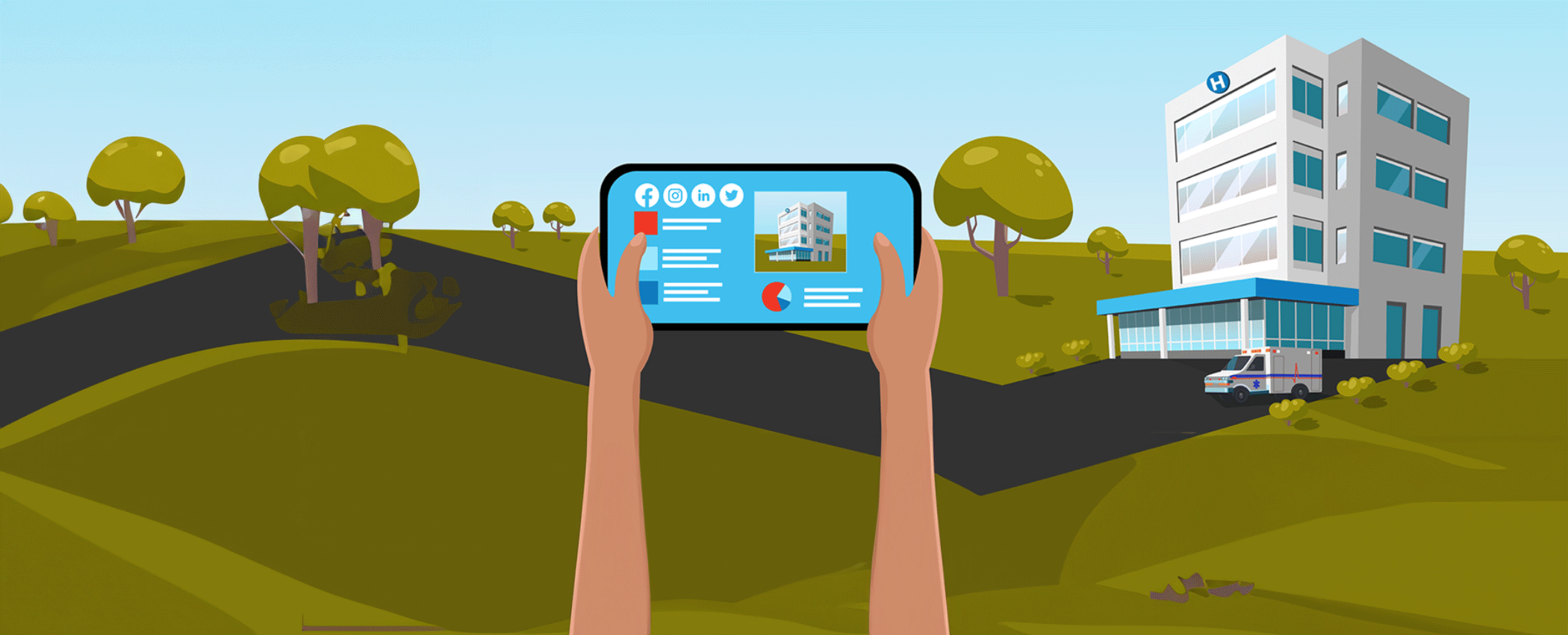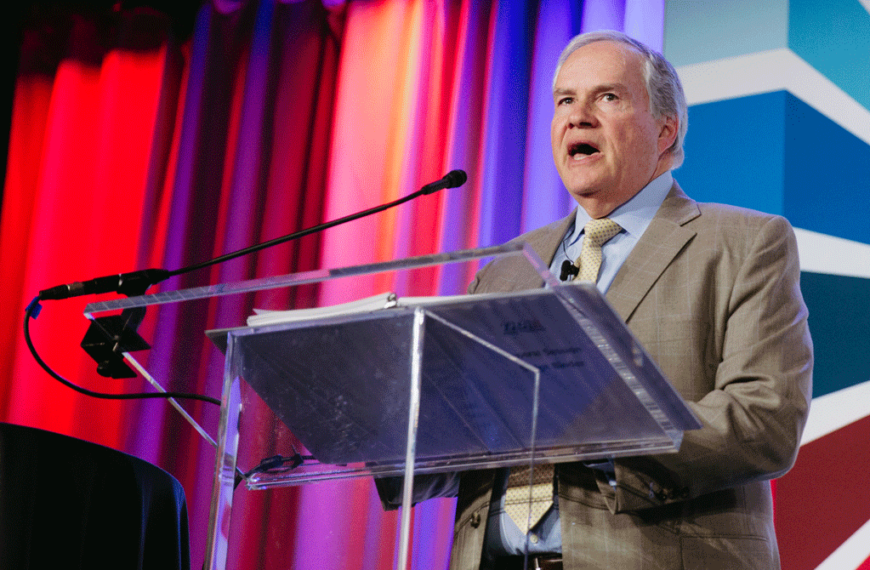In a space encumbered by new features, trends and algorithmic best practices that change daily, the job of a social media manager in 2023 can feel overwhelming. Especially if you’re doing the job alone.
Most rural hospitals’ social media platforms are managed by a very small team of communications professionals – or a team of one – who are responsible for managing a content calendar, creating the content, monitoring engagement, analyzing performance and even doing paid social media placements.
However, rural hospitals’ weakness is also their strength. Unlike large brands that are preoccupied with building an audience, rural hospitals are building online communities, which is far more impactful. Rural hospitals are part of the everyday life surrounding them, making social media engagement feel like an extension of day-to-day interactions with neighbors, co-workers and friends.
“I think working in a rural community has been to our benefit because the people you see in our photos are the same people you see in the grocery store, and then you walk in the hospital, and it’s the same familiar faces,” says Gabriela Anfinsen, marketing coordinator at Uvalde Memorial Hospital. “We are a tight-knit community and that’s reflected in our social media.”
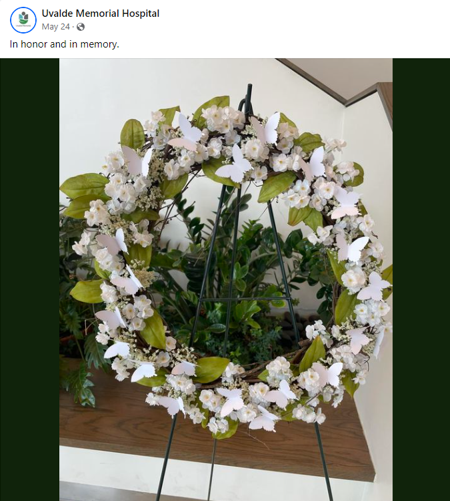

Gabriela is part of the four-person communications team at Uvalde Memorial Hospital and is responsible for all of the hospital’s social media marketing. She is responsible for strategic content ideation, creation and management – responsibilities that would likely be spread across several communications professionals in large companies or in other industries.
Despite bandwidth and budgetary challenges, with the right strategies, tools and support, it’s possible for rural hospitals to cultivate a meaningful social media presence that impacts patient satisfaction and community perception.
Here is a framework that outlines the five W’s to consider with guidance and insight from other Texas hospital marketers.
Why Your Rural Hospital Should be Active on Social Media
Anyone who has been in the marketing space for a while might recall the days in the early 2010s when organizations questioned if having a social media account was even necessary.
Those days are long gone.
While hospitals are not using social media platforms to sell products like a B2C brand, they are using it to connect with their communities. For hospitals, which are often the heartbeat of a community, social media is not a vehicle to sell services, it’s a mechanism to communicate to the communities that depend on them.
“COVID was a launching point for us. We used our Facebook page and Facebook Live to communicate with our community during COVID and it was a lifeline when everyone was separated,” recalls Tracie Smith, senior director of Marketing at Titus Regional Medical Center in Mt. Pleasant, Tex.
Beyond the perfunctory obligation to have a social media presence, here are the tangible reasons rural hospitals should embrace social media as part of their marketing
- It’s cost-effective. Compared to traditional marketing channels like print, television or PR campaigns, social media marketing is considerably cheaper – it’s the only form of advertising today that can expose you to over 1,000 people for less than $3. This allows small organizations like rural hospitals to reach large audiences without spending a significant amount of money.
- It provides control of content distribution and storytelling. Rather than waiting for a local news source to pick up a story, rural hospitals can share content like blog posts, videos, patient and staff stories and more. With social media, you can freely and easily share your hospital’s story, share valuable information, showcase your expertise and establish your hospital as a trusted authority within your community.
- It helps you reach a very targeted audience. Social media platforms offer sophisticated targeting options, allowing you to reach specific demographics, interests and behaviors. This capability enables rural hospitals to focus their marketing efforts on the most relevant audience, maximizing the impact of their campaigns.
- It allows for adaptability and flexibility. Social media allows rural hospitals to be nimble and the flexibility to experiment with different strategies, analyze results in real-time and make adjustments based on performance.
- It provides valuable market insights. Social media platforms provide valuable analytics and insights into consumer behavior, preferences and trends. Small business owners can gather data on customer demographics, engagement rates, content performance and more. This information can guide strategic decision-making and help optimize marketing efforts.
Where You Post Content
To know the best way to make social media work for you, you must first understand the various social media platforms, what they’re used for and who is using them.
Below are the top five most popular social media platforms by monthly active users (MAUs), a key performance indicator used by social media companies to count the number of unique users who have visited a site within the past month.
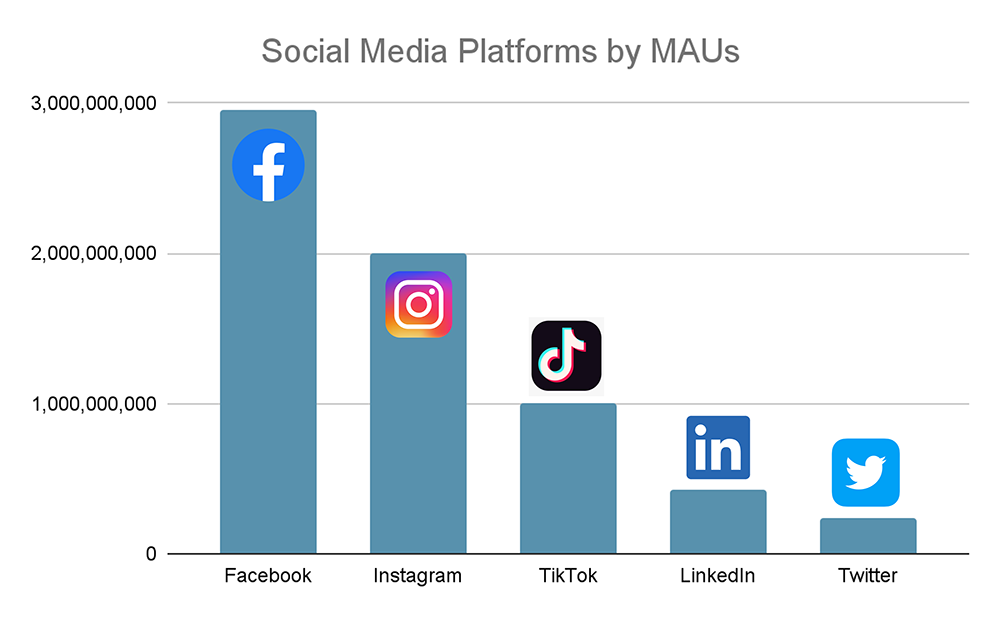
Facebook. Facebook’s motto is “Bring the World Closer Together.” It is one of the most popular platforms with nearly 3 billion people using Facebook monthly. This platform is best used for reaching new audiences with a limited budget to spend on ad content, conducting giveaways and contests, sharing a more authentic side of businesses, and engaging with your audience.
Instagram. Instagram is one of the more visually driven platforms. Its tagline is “Capture and Share the World’s Moment.” Users share photos and videos through posts, stories, reels, live videos and more. The platform has seen exponential growth in business accounts since its genesis with more than 90% of accounts following at least one business on Instagram and 81% of users saying that Instagram helps them research products and services. Surprisingly, business accounts with less than 10,000 followers perform the best. The platform is a great option to showcase your services through photos and videos, create brand awareness and loyalty through daily stories and Instagram live and post informational content with swipe-through, multiple photo carousel posts (which have seen the best organic engagement rates on the platform).
LinkedIn. LinkedIn is known as the professional social media network. Its motto is “Connecting the world’s professionals to make them more productive and successful.” This platform values expertise, thought leadership and a unique professional perspective. LinkedIn content that typically performs well includes text-only posts that distinguish you as a thought leader in your space, polls that allow you to gather information about your audience, articles or newsletters that can be written and published directly in the platform, and content that solicits comments as that boosts performance.
X (formerly Twitter). With the tagline “It’s what’s happening,” X is the world’s newsfeed. It is a fast-paced, up-to-the-minute social media platform with 350,000 tweets sent per minute and 500 million tweets sent daily. High-volume X users (users who tweet 20+ times per month) say they use the platform to “stay informed” and “express their opinions.” This platform values the sharing of ideas over aesthetics and encourages engagements and the cultivation of conversation, however, it is not the best place for advertising.
TikTok. Tikok is the newest of the top five most popular platforms. Its tagline is “Real people. Real videos.” Since it was created in 2017, TikTok has quickly surpassed Google as the most-visited internet site. TikTok’s algorithm prioritizes relevant and relatable content in video format, and its interface makes it easy for users to spot the latest trends and create informational or educational content for audiences to engage with.
Who Are You Posting For
Regardless of size or industry, organizations must ask themselves, “who is this content for?” Marketers have to keep these target audiences in mind whenever they’re planning, creating or posting content.
For most rural hospitals, their audience will consist of patients, community members and hospital staff.
“It can be hard to stay on top of trends, but we have to keep in mind what is relevant to our community and demographic,” says Kaitlyn Hankins, PR & marketing coordinator at TRMC. “For instance, everyone was curious about [Instagram} Threads, but we know most people in our community won’t care about Threads and that’s ok.”
Here’s a breakdown of the primary demographics you should consider on each social media platform:
Facebook:
- Facebook is the most popular with older millennials aged 35-44;
- 56.6% of Facebook’s ad audience is men; and
- 70% of adults in the U.S. use Facebook and 49% report they visit Facebook at least once a day.
Instagram:
- 62% of users are ages 18-34, 16% are 35-44; and
- Of U.S. Instagram users, 46% live in urban areas, 35% in suburban and 21% rural.
LinkedIn:
- 71% of all LinkedIn users are ages 35-55; and
- Over 70% of LinkedIn users attended college.
X:
- Worldwide, 38.5% of X users are 25-34, the largest age group of the app; and
- 56.4% of X users are male, while 43.6% are female.
TikTok:
- 47% of TikTok users are between ages 10-29, so younger age demographic; and
- Roughly 90% of users access TikTok every day.
What Content You Should Post
When it’s time to plan your hospital’s content, ask yourself these three questions:
- Is this content informative?
- Is this content entertaining?
- Is this content persuasive?
As a general rule, 80% of the content you post on social media should meet one or more of the three parameters listed above without being overtly promotional.
Hankins points out that the Titus marketing team is deliberate about how much promotional content they post, saying, “Our social media is a mix of information and inspiration. We don’t want to just be a bulletin board. We educate, we tell stories and provide information about bigger news topics that are happening.”
Creating Your Hospital’s Content Niche
Creating content for hospitals can be difficult because hospitals provide services that are rarely desired, but deeply necessary. Rural communities might not have much choice in where they seek care, but as a marketer, you have the responsibility to convey the unique value proposition of your hospital.
If you find yourself stuck generating content ideas, consider creating a content niche Venn diagram to identify three unique areas of expertise that set your hospital apart.
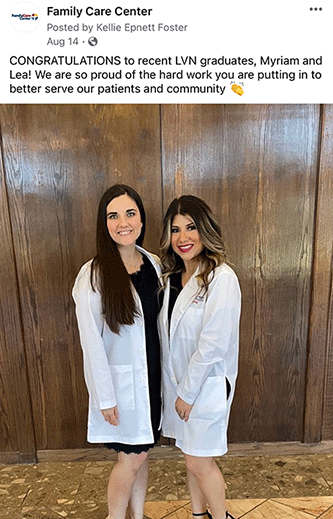
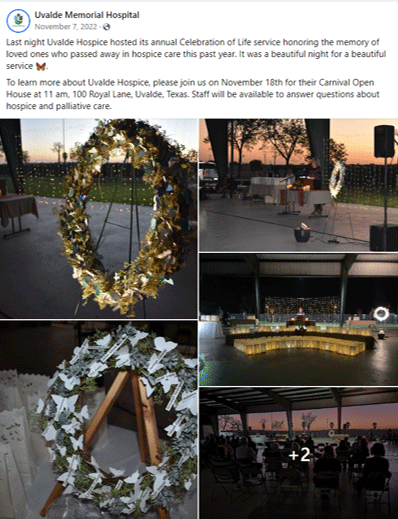
Your hospital doesn’t need to be an industry leader in any of these areas, but you should select areas in which your hospital excels or where the community’s perception of your hospital is considerably high.
This might include:
- Community outreach;
- Training and education;
- Research and innovation;
- Employee engagement;
- Areas of specialized care;
- Clinical excellence;
- Patient satisfaction; or
- Quality and safety.
Keep in mind that the more specific you are, the more universal you are. For instance, “clinical excellence” is broad and somewhat vague, but “clinical excellence in postpartum care” is more specific and will better resonate with your audiences.
Example
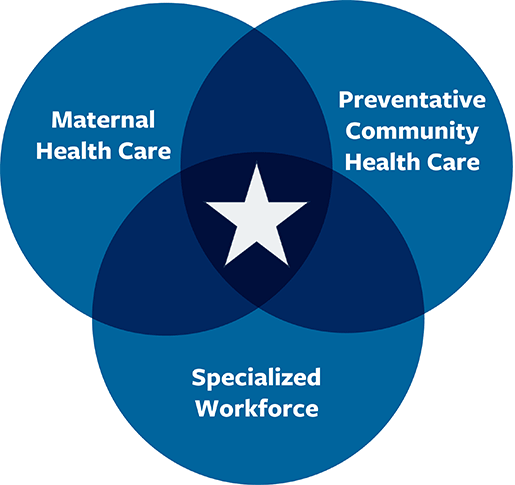
Pro Tip: If you have a hospital staff member who is especially gregarious, camera-friendly or a pillar in the community, consider using them in recurring posts. Familiar faces will always outperform stock imagery and scale your post engagement and reach.
Uvalde Memorial Hospital and Titus Regional Medical Center have both found significant success with this tactic.
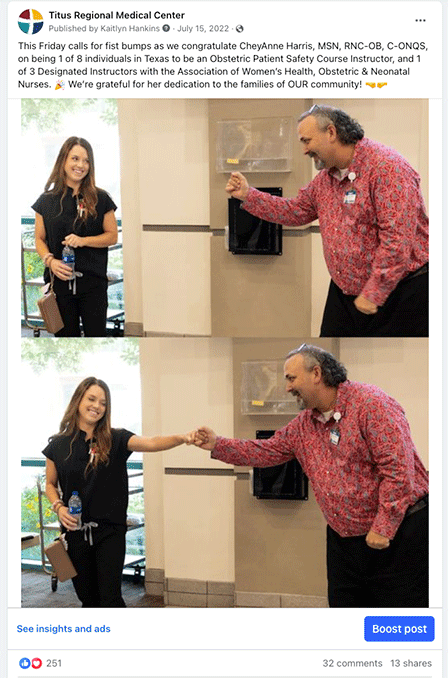
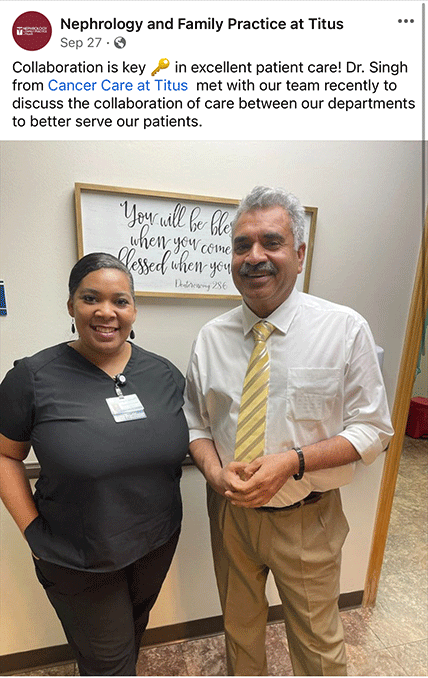
“There are people in the hospital who film and photograph well, and it’s fun to see them come out of their shell and that’s the type of content that gets shared a lot and brings a lot of traffic to those posts,” says Anfinsen.
“We have a pediatrician here who, if you put his picture on a social media post, it will hit 10,000 impressions within a couple days,” says Smith. “Because he has such a far reach in the community.”
When Should You Post
The best times to post on social media can vary based on your target audience, geographic location, industry and the specific behaviors of your followers.
As a general rule, B2B social media platforms like LinkedIn and X will have heightened engagement during business hours and content on B2C platforms like Facebook and Instagram will do better on evenings and weekends.
“Posting in the evenings versus the daytime can make a huge difference in reach,” says Kellie Foster, social media content coordinator at TRMC. “As people get home from work and settle in for the night, one of the top things to do to unwind and relax is to scroll through social media.”
The following guidelines are based on recent research from Hootsuite, a leading social media management tool and can be used as a starting point for novice social media managers. Keep in mind the ideal times to post can change as platform algorithms and user behaviors evolve.
| Weekdays | Weekends | |
|---|---|---|
| Mondays and Tuesdays at noon CST | Mid-morning, around 10 am CST | |
| Mondays and Thursdays at 10 am CST | Engagement tends to be lower, but if targeting, consider late morning. | |
| Between 7 am and 9 am (before work), and 5 pm to 6 pm (after work). Lunch hours, around noon, can also see higher engagement. | Generally less engagement. If you must post, consider either late afternoon on Saturday or early mornings on Sunday. | |
| X | Thursdays at 1 pm CST and Friday at 11 am. | Engagement tends to be lower, but if targeting, consider late morning. |
| Tik Tok | Thursdays at 9 pm or late afternoon (3 – 5 pm) on other weekdays. | Saturday at 11 am CST and Sunday at 3 pm CST. |
How to Get Started
If you’re starting from ground zero and have no active social media accounts, the No. 1 thing you should do is create a Facebook business profile. Facebook is not only the most used platform, but it also has robust backend analytics to provide users with audience insights. Create a business profile, use those analytics to understand your audience, start creating content and continue to monitor how it performs, and if you have a post that does really well, consider putting some money behind it to boost it even more.
Get Started from Ground Zero
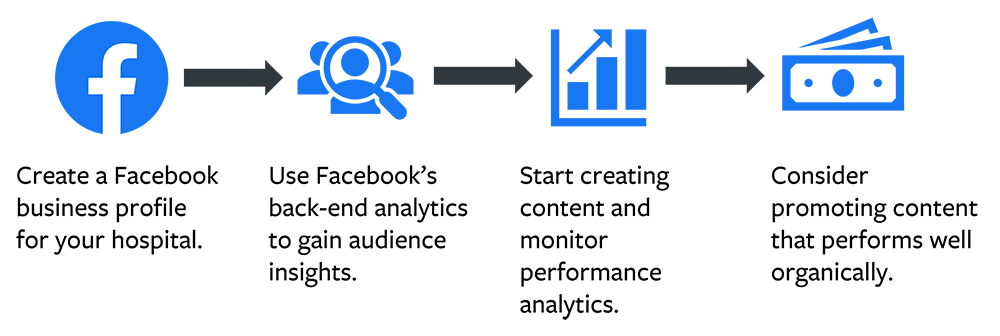
If you already have social media platforms, start to expand your strategy by making a content calendar. Look at upcoming topics and dates and, keeping your goal in mind, plan your content out in advance. Then, develop that content and schedule it ahead of time. A great way to get ahead on social media is by creating a suite of evergreen content by identifying key messages that can be reused and building a repository of “off-the-shelf” content.
Once you have a strong social media presence, always be sure to maximize your efforts by repurposing web, email and other long-form content for social posts, and reuse well-performing social content across your various platforms.
Bonus: How to Spend $100 on Social Media Advertising
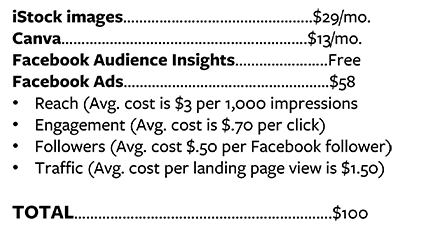
Once you’ve built a steady content calendar, you might boost your content’s reach with paid placements on social media. This is a form of advertising where social media posts that were initially created for organic reach are boosted financially to appear to a larger or more targeted audience.
If you don’t know what type of content you should boost, look at what has performed well organically and consider either scaling it – or content similar to it – with paid placements.
Of all current social media platforms that offer advertising, Facebook is the most cost-efficient due to the high number of Monthly Active Users. This makes it a good place to start if you are not familiar with social media advertising yet.
Typically, Q4 is the most expensive quarter for paid placements on social media, so avoid heavy paid promotions toward the end of the year if possible.
Here’s how you could spend $100 on social media:
For only $100, you can create a piece of content that will yield approximately 38 visits to your hospital’s website, garner 19,000 impressions, get 82 engagements on your content or gain 116 new followers on your page.
The Facebook Ads Manager platform democratized online advertising, making it easy for someone with little experience to set up online ads. Meta, the parent company of Facebook and Instagram, often offers one-on-one training with new users of the Ads Manager platform to ensure best practices are followed.
Once you become familiar and proficient with Facebook Ads Manager, which also allows you to promote content directly to Instagram, you can start branching out to other ad platforms like LinkedIn, Twitter or Tik Tok.
Be an Anchor
If you’re part of a small communications team with limited bandwidth and budget, keep in mind that while social media platforms’ algorithms, feeds and interfaces differ, they share a fundamental common trait and mission: to connect people. High engagement rates and organic reach are an outgrowth of genuine, organic connections.
For rural communities, hospitals are often their heartbeat and lifeline. It’s one of the area’s primary employers, a source of security and a critical health care access point for residents. As long as connection remains at the heart of what social media delivers, then rural hospitals, which are at the heart of their communities, have a unique advantage over organizations that use social media as a vehicle to sell.
Smith recalls the early days of the pandemic when their social media platforms were a trusted source of information for the Mt. Pleasant community via daily Facebook Live updates from their CEO. Every day, hundreds of patients, staff and members of the community tuned in to stay informed and engaged with their hospital.
“In the midst of all the chaos, we kind of became a little anchor in our community.”
Related articles from The Scope
Hospital Physician Executives are Tackling Texas Health Care Challenges
The Texas Hospital Association provided an open forum for physician executives to talk about the hottest topics in the health care space, while also learning up-to-date legal and political news…
Beyond the Stethoscope: Highlighting Texas Physicians on National Doctor’s Day
Each year, National Doctor’s Day provides health care institutions, patients and the community with an opportunity to celebrate the physicians who dedicated their life’s work to improving others’ health. It…
Congratulations to THA’s March Newsmakers
THA’s Newsmakers highlights leaders from THA member hospitals and health systems making headlines in Texas health care. Please join in congratulating our March Newsmakers: Lucy HedariMedical City Decatur Lucy Hedari…
Change Healthcare Breach is a Sobering Wakeup Call on Cybersecurity
It seems that every month, the threat becomes greater and greater for hospitals across the country: the possibility that bad actors can disrupt the hospital’s operations – or effectively bring…
